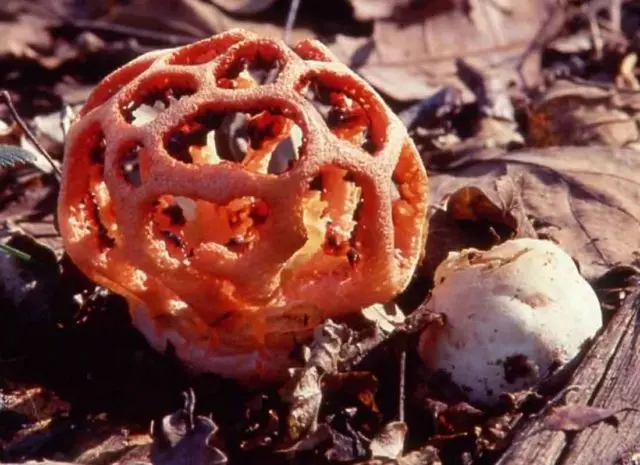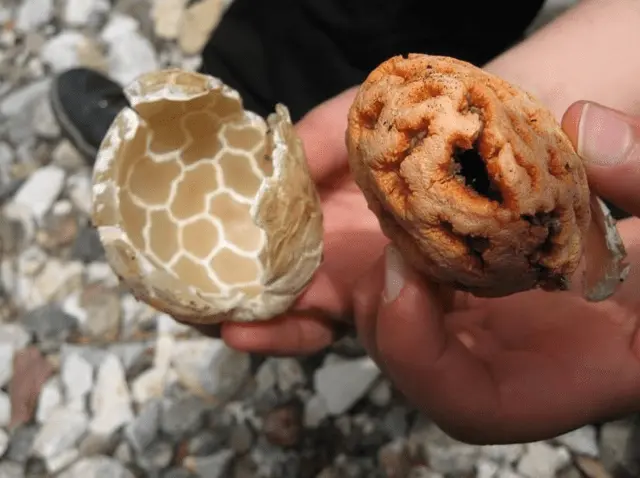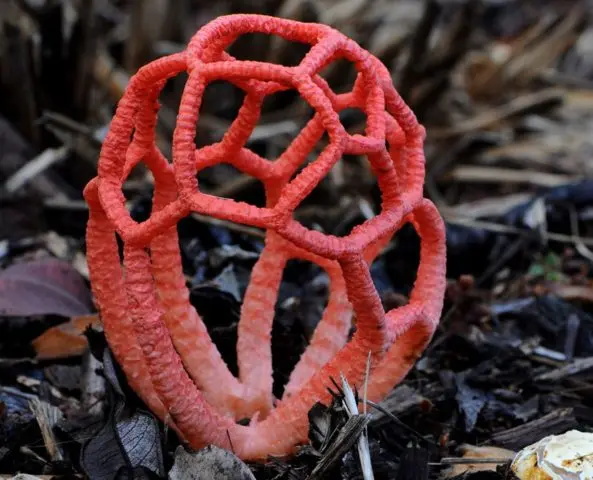Contents
Lattice red or red clathrus is a mushroom that has an unusual shape. You can meet him in the southern regions of Our Country throughout the season, subject to favorable conditions. The fungus grows singly and in groups. The official name is Clathrus ruber.
Description mushroom grate red

Lattice red belongs to the Veselkovye family and to the group of Gasteromycetes or Nutrients. It is distantly related to raincoats. Its main difference from other species is that the spores ripen inside the fruiting body under the cover of a dense shell. As it grows, it collapses, and under it a fruiting body appears from an unusual lattice mesh with irregularly shaped cells, without a leg. Their number varies from 8 to 12 pieces. Most often, the fruiting body is red, but in some cases there are instances of a whitish and yellowish hue.
On the reverse side, the connecting bridges are covered with a greenish-olive spore-bearing mucus that exudes a concentrated smell of rotting flesh. This helps the fungus to attract the attention of insects, with the help of which it spreads to the surrounding areas. An unpleasant odor is emitted only by those specimens in which the spores are fully matured. Their specific aroma extends up to 15 m around.
The spores of the red trellis are ellipsoid, smooth, colorless, thin-walled. Their size reaches 4-6 x 2-3 microns.
Pulp of loose consistency, soft, spongy. It is easily destroyed even with a slight physical impact.
Where do red trellises grow
Lattice red prefers to grow under broad-leaved trees, around which the soil is rich in humus. Also a favorable environment for its germination is a wet litter of fallen leaves and rotting wood residues. In exceptional cases, this species can grow in mixed forests.
Red Lattice belongs to the category of heat-loving mushrooms, so it is able to survive only in those regions where the temperature does not fall below -5 degrees, regardless of the time of year. Therefore, the red lattice can be found in the Krasnodar Territory, in the Caucasus and in the Crimea, mainly in those places where there is little illumination in the daytime. If the temperature drops below a critical point, the mycelium of the fungus dies.
Outside of Our Country, the red lattice is found in European countries with favorable climatic conditions. Also, its distribution area is North America, North Africa and the Mediterranean region.
There were also cases of fungus germination in greenhouse conditions, when its spores were brought along with the soil. It was in this way that this species came to Siberia, to the city of Gorno-Altaisk. The red trellis mainly grows in single specimens, but under conditions of high humidity and air temperatures above +25 degrees, germination of group plantings is possible.
Fruiting continues from spring to autumn. In this case, the fungus germinates only under favorable conditions.
What do the red bars look like?

As can be seen in the photo, the red lattice mushroom has a spherical or ovoid body in the form of a lattice, for which it received its name. But it acquires this form as it matures.
At the initial stage of development, the fruiting body of the lattice has a dense red color with small black patches, which is in an ovoid shell of a light shade. Its height is 5-10 cm, and its width is about 5 cm.
As it grows, the outer shell breaks and under it you can see several independent red petals that are attached to one base. In the process of development, they tend to the ground and round off, forming a mesh ball, consisting of separate cells connected to each other. The bridges are covered with jagged jagged fringe of dense structure, and its shade does not differ from the color of the fruiting body.
The height of an adult mushroom varies between 10-12 cm, and the width is about 8 cm. In the form of a formed lattice, it can be stored for 120 days.
Edibility of red trellises
The red lattice mushroom belongs to the category of inedible mushrooms, so you can’t eat it, as it is dangerous to health. But it is unlikely that anyone will be able to seduce such an unusual appearance of the mushroom that they want to try it. And in combination with the unpleasant smell of carrion that it exudes, this only strengthens the desire to bypass it.
However, if this species is found, it is strictly forbidden to pluck it, due to its small number. Therefore, if you happen to meet him, you must inform the environmental institution.
In addition, the red color of the mushroom signals danger, so even without knowing whether the edible lattice is red or not, this is an alarming sign.
How to distinguish red latticeworkers

The unusual appearance of the red lattice will not leave anyone indifferent. Therefore, it is impossible to confuse it with other mushrooms. In addition, there are a number of differences that noticeably distinguish it from other species.
Characteristic features:
- ovoid light shell;
- red hue of the fruiting body;
- irregular cell shape;
- unpleasant putrefactive odor when ripe;
- absence of a leg;
- jagged fringe along the edge of the bridges.
Conclusion
The red lattice is one of the rare species of mushrooms that are on the verge of extinction. It is of interest only to specialists in order to study its properties. Therefore, when you find it in the forest, it is worth remembering that it is protected by law and is a unique creation of nature, so you should not pluck it out of simple curiosity.









